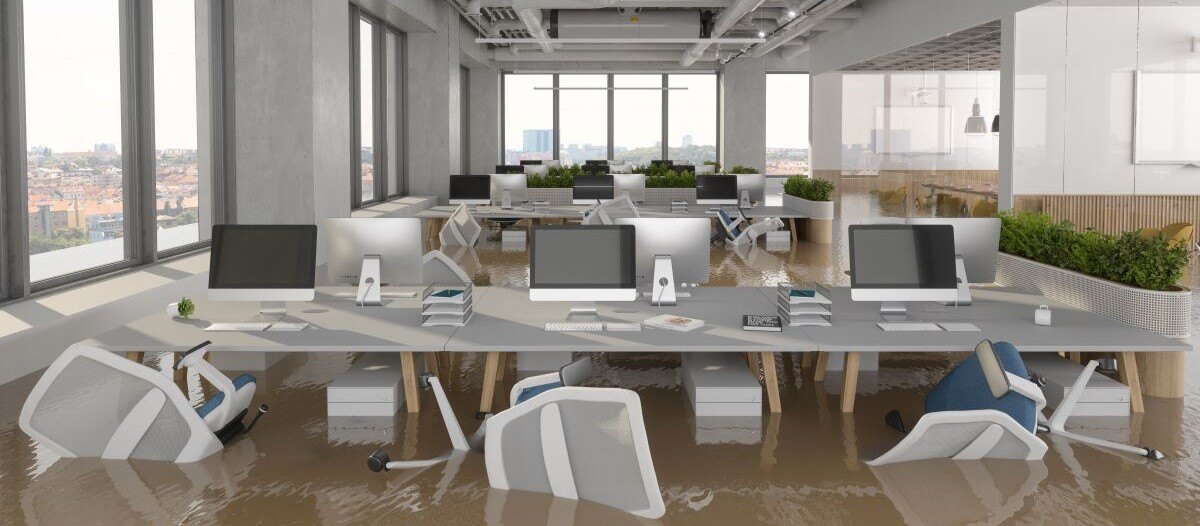After the Storm
Navigating natural disasters with business continuity strategies

The ability to weather a natural disaster is not just about the survival of a building; maintaining critical functions until business can resume as usual is key to the viability and long-term success of a business. Yet, more than half of businesses in the United States do not have a disaster recovery plan. Of the businesses that close temporarily because of a disaster, at least one in four will never reopen.
In recent years, there has been a surge in the frequency and severity of severe weather and wildfire events that pose significant threats to businesses and their facilities nationwide. Economic losses associated with these events have skyrocketed; however, organizations can go beyond mere survival in the face of adversity with the right mitigation and recovery strategies in place. Property owners and facility managers should develop a continuity plan tailored to their business, which can guide actions to minimize disruption during and after a natural disaster.
Understanding the risks: Natural perils, including hurricanes, severe convective storms, earthquakes, wildfires, winter weather and floods, pose significant threats to facilities. FMs must focus on ensuring continued operations, so it is critical they understand a facility’s vulnerability to natural hazards.
Buildings are exposed to a multitude of perils, often unique to their location. A property in Orlando, Florida, USA, is exposed to hurricane-force winds, while a building in Buffalo, New York, USA, will face severe winter weather. Other hazards, such as flooding, can pose a risk to all facilities, no matter the location. Start by identifying potential risks to a location using tools like the following:
After identifying natural perils, plan and conduct an annual risk and vulnerability assessment as part of overall business protection planning.
Recognizing the multifaceted nature of these hazards and their potential impact on operations is essential for building resilience, and it can change over time. Each year, consider the following:
- Are there any new external threat-based factors like population changes or new transportation routes?
- Are there combinations of events to prepare for or the possibility of one event causing another, also known as cascading failures?
- Can new technological protection devices, safeguards or procedures be put in place to reduce business exposure by preventing avoidable damage that could lead to costly repairs or shutdowns?
- Is current insurance coverage still sufficient, or have there been changes to the property? Be sure to review this with an insurance agent.
Assessing vulnerabilities & planning accordingly: The Insurance Institute for Business & Home Safety (IBHS) is a research organization dedicated to helping commercial property owners and managers reduce their risk of damage from natural disasters. IBHS conducts full-scale research on structures to identify areas of vulnerability and solutions to mitigate. The nonprofit also offers resources to help assess vulnerability to natural disasters and put a business continuity plan in place. Through comprehensive risk assessments using tools such as IBHS's OFB-EZ, Business Continuity Planning Toolkit and EZ-Prep, Severe Weather Emergency Preparedness and Response Planning Toolkit, organizations can identify potential weak points in both operations and infrastructure. This enables leaders to craft tailored continuity plans that mitigate risks and enhance resilience across key areas.
Developing a robust continuity plan: Armed with insights from risk assessments, FMs can develop robust continuity plans encompassing a range of strategies.
From emergency response protocols to backup systems and alternative suppliers, it is important to create a dedicated business continuity team to oversee plan development and implementation. Business disruptions come in all shapes and sizes — the best way to prepare is to expect the unexpected.
Consider the following:
- What are the most critical and time-sensitive functions to stay in business?
- Which functions should be classified as highest priority, medium priority and lowest priority?
- How much downtime can my business tolerate for each business function?
- Which business functions are necessary to fulfill legal and financial obligations and maintain cash flow?
- Which business functions are essential to maintain market share and reputation or to strategically adjust to changed circumstances?
The best way to answer these questions is to think through business processes and meet with key employees to document their business functions, including dependencies on supplies, equipment and third-party vendors. One of the advantages of using OFB-EZ is the guidance it provides to help identify critical functions that might not appear obvious because they are completed daily without much thought.
Once essential business functions have been identified, rank them in order of importance. How should recovery priorities be determined? First, determine the maximum amount of time allowable to restore each business function after a disaster or disruption to avoid unacceptable consequences or adversely affect overall business operations. These timeframes can be a few hours or as much as 30 days or longer.
Crisis communication: Clear communication channels and protocols ensure seamless coordination during crises, facilitating swift decision making and response efforts. Information is critical during catastrophic events and emergencies. Precise, timely and relevant information is essential for businesses to maintain trust and credibility; for employees, customers and vendors, it can help in decision making that may affect personal safety or productivity. Most importantly, it is vital to help provide rapid and appropriate assistance to those who need it following a crisis.
Maintaining current contact information for staff will ensure they are reachable to determine their safety and whereabouts, inform them about the status of operations, as well as when, where and how they should report to work and provide any additional instructions following a disruption.
Every business should have a crisis communications plan in place to ensure accurate information is provided before, during and after a disruption, minimizing problems caused by untimely or unclear communications.
Prepare message templates in advance to save time. When an incident occurs, these can easily be tailored to the disruption and recipient, whether it is a staff member, customer, supplier or vendor, creditor or even a neighboring business. The key to communicating with stakeholders is to be accurate, complete, consistent and timely, with messaging appropriate to the audience so expectations are clear.
When the worst is over and things settle into the new normal, meet with employees for a debrief to review procedures, solicit their input on what was successful and what was not, and incorporate improvements into plans moving forward. This is an excellent opportunity to get employees involved, allowing them to provide input and feel heard.
A business’ ability to survive and eventually thrive after a disaster is dependent upon the human factor in all aspects of planning, response and recovery. Helping employees prepare for a disruption will, in turn, prepare them to return to work faster and help restore normal operations more quickly and efficiently.
Protecting the building: Preplanning for protection of the building envelope and surrounding property should be included in an organization’s severe weather planning. All plans should include best practices to take before, during and after an emergency, along with actions to address unique challenges that are specific to each business’ facilities and operations and the risks they face. IBHS's EZ-Prep tool walks FMs through, in chronological order, best practices throughout the year. For example, steps to take during the offseason may include major repairs such as roof cover replacements, addressing building leaks, obtaining flood protection, replenishing emergency supplies and more. Life safety is always the top concern, and precautions to ensure staff safety before, during and after a storm are critical. If staff members are to ride out a storm at a company facility, steps must be taken to ensure their safety and comfort. Effective plans also include designated responsibilities for personnel, with alternates assigned. EZ-Prep is an easy tool that addresses these items and provides additional guidance to create a thorough plan.
For recovery, it can be helpful to have agreements in place for important services needed prior to or following a severe weather event. An agreement with a disaster recovery company can significantly reduce downtime since they are already familiar with the building. The same goes for roofing contractors. They can come to a facility for an inspection in advance so they already understand roof vulnerabilities and can better anticipate repairs that may be needed. If a standby generator is in place, obtain a contract from two providers to deliver fuel before and/or after an event. Generators can also be rented and delivered.
Building a culture of preparedness & training: Effective business continuity planning begins with fostering a culture of resilience and preparedness. Leaders empower staff to respond effectively to crisis situations through continuous training and education.
Testing & evolving continuity plans: Continuity plans should evolve and require regular updates and testing. Tabletop exercises and drills provide opportunities to test disaster readiness, train employees, improve employees’ ability to make informed decisions when responding to an emergency, identify what needs to be done before, during and after a disaster, and examine a specific scenario or situation more closely. The OFB-EZ toolkit offers an effective power outage exercise to get started.
In the aftermath of natural disasters, minimizing disruption to the facility – and resulting operations – is the top priority. From understanding risks and assessing vulnerabilities to testing continuity plans, businesses can navigate the challenges posed by Mother Nature.

Chuck Miccolis provides engineering and technical support for commercial building–related hazard mitigation initiatives. He is the lead engineer for the Institute’s FORTIFIED Commercial standards, a voluntary commercial construction criterion that focuses on building resiliency and mitigating losses from natural and human-caused hazards. He works with IBHS colleagues, member companies, and industry trade organizations on program development, mitigation, field research, and testing at the IBHS Research Center. Prior to joining IBHS, Miccolis was in the commercial property insurance business for more than 20 years.
Read more on Operations & Maintenance , Real Estate and Risk Management
Explore All FMJ Topics









